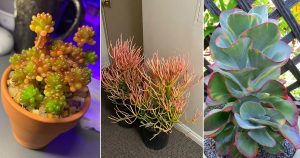Cacti are notorious for being prickly, but these Cactus Without Spines, Thorns, and Needles are the interesting exception!
Add these thornless cacti to your garden, which are not only free from spines but also offer colorful, beautiful flowers.
Cactus Without Spines, Thorns, and Needles
1. Orchid Cactus
Botanical Name: Epiphyllum
Orchid Cactus’s large, fragrant flowers come in various colors, including white, pink, red, and yellow. These are epiphytic cacti, which you will often find growing on trees in their native habitats, where their flat, leaf-like stems make them look nothing like those thorny cacti varieties.
They love indirect sunlight, preferring a bright spot indoors or under dappled shade outdoors. To see them bloom in full glory, you can keep them slightly root-bound and water sparingly when the topsoil feels dry.
2. Christmas Cactus

Botanical Name: Schlumbergera truncata
This one has beautiful, segmented stems and tubular flowers that bloom around Christmas, which is why it is called Christmas Cactus. It is a good idea to place it in the kitchen or bathroom area, where it will benefit from the humidity that it loves.
If you care properly, it can live for decades and even be passed down as a family heirloom! For best results, water it when the topsoil feels dry, and avoid letting it sit in waterlogged soil.
3. Mistletoe Cactus
Botanical Name: Rhipsalis baccifera
Mistletoe cactus is an epiphytic cactus with trailing, pencil-like foliage that grows on trees in its natural, tropical habitat. It grows naturally in rainforests and is unique for its lack of spines and needle-like look. Ensure that you give it well-draining soil and water it a bit more regularly than your classic desert cactus.
Like Christmas cacti, it also loves humidity so, you can keep them in the bathroom or a spot near a humidifier.
4. Easter Cactus
Botanical Name: Rhipsalidopsis gaertneri
Named for its blooming period around Easter, this cactus features flat, segmented stems and bright, star-shaped flowers. The colors of this cactus blooms are attractive in shades of pink, red, and orange, and their blooming period, coupled with flower shape, makes them easily distinguishable.
And if you want to see it flower consistently around Easter, give it cool temperatures and long nights in late winter.
5. Hurricane Cactus
Botanical Name: Lepismium cruciforme
Do you want the best option for your hanging baskets? If so, get yourself a Hurricane Cactus with amazingly lush, cascading greenery. This cactus variety has cylindrical or flat stems and small, white, or pink flowers that are just icing on the cake!
In addition, provide it with filtered light, well-draining soil, and occasional misting to mimic its tropical rainforest roots.
6. Red Rhipsalis

Botanical Name: Pseudorhipsalis Ramulosa
Look at the beauty! This is a shrubby, epiphytic cactus with freely branching, reddish tapeworm-like foliage. Red Rhipsalis produces numerous green-white or pink flowers, which are followed by small, ornamental shell berries lining both edges of its stems.
7. Bishop’s Cap.

Botanical Name: Astrophytum myriostigma
The Bishop’s Cap cactus, with its five distinct ribs and frosty white-dotted surface, looks like something out of a desert fairytale. It’s low-maintenance, preferring dry, sandy soil and full sun exposure.
Astrophytum myriostigma is more special for its occasional yellow blooms, which are the cherry on top of its unique geometric shape. If you’re looking for a hardy, drought-tolerant companion, this cactus is a must-have.
8. Fishbone Cactus
Botanical Name: Selenicereus anthonyanus
Also known as the Ric Rac Cactus, it has flat, zigzagged stems that resemble fish bones. What makes this cactus unique is that it blooms at night with large, fragrant flowers. Water your Fishbone Cactus when the soil is dry to the touch, and make sure the pot has plenty of drainage holes.
Who says cacti have to be prickly to be beautiful? These thornless cactus varieties are proof that you can enjoy the charm of cacti without worrying about those pesky spines. Do you already have one of these in your collection, or are you planning to add one? Let us know about your experiences, tips, or any other thornless cacti you love! Share your thoughts in the comments below!












